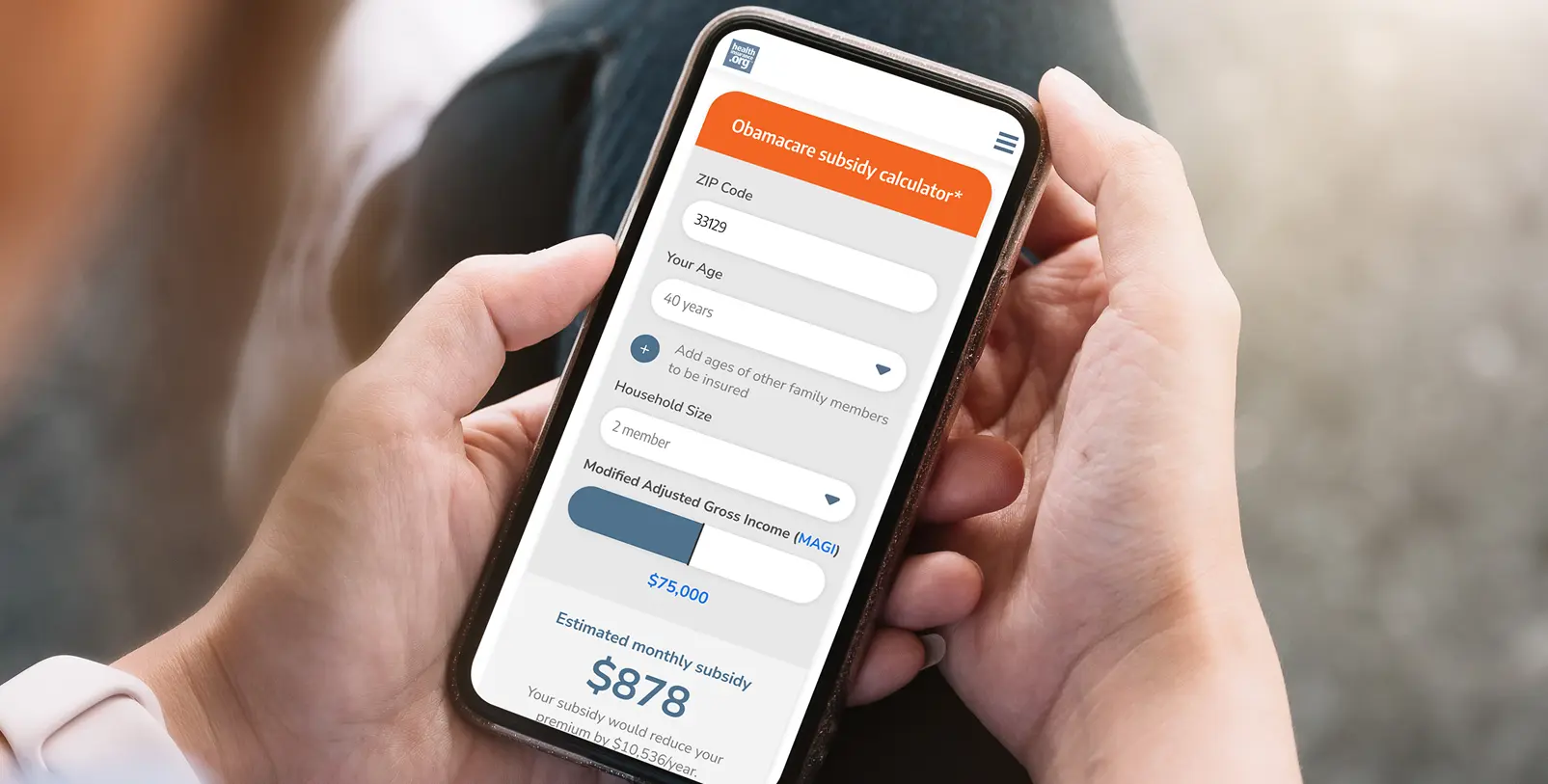
In this article
If you’re shopping for health insurance in the Marketplace/exchange (in other words, an Obamacare health plan), you might be eligible for income-based premium subsidies that cover a significant portion of your monthly premiums.
But as we approach the start of the open enrollment period for 2026 coverage, Congress has not extended the subsidy enhancements that have been in place since 2021. If those subsidy enhancements are allowed to expire as scheduled at the end of 2025:
- The "subsidy cliff" will return in 2026, as subsidies will no longer be available to anyone with a household income above 400% of the 2025 federal poverty level.
- For applicants with household income that doesn't exceed 400% of FPL, subsidies will no longer cover as much of the premiums as they did in 2025. This is because households will be expected to pay a larger share of their own premiums.
Who's eligible for ACA premium subsidies?
Subsidy eligibility is based on household income, as explained in more detail in our overview of Marketplace premium subsidies. If Congress doesn't extend the subsidy enhancements, subsidies will only be available in 2026 if your household income doesn't exceed 400% of the 2025 federal poverty level.
Of the nearly 23.4 million people who were enrolled in private plans through the exchanges as of early 2025, 93% were receiving premium subsidies.1 But in early 2021, before the subsidy enhancements had been put in place, 86% of Marketplace enrollees were receiving premium subsidies and total enrollment was less than half of the 2025 enrollment, with only 11.3 million people enrolled in early 2021.2 If the subsidy enhancements aren't extended, we can expect to see lower enrollment and a lower percentage of enrollees receiving subsidies in 2026.
- Learn how pre-tax retirement account contributions and health savings account (HSA) contributions can reduce your ACA-specific modified adjusted gross income that's used for subsidy eligibility calculations.
- And learn about how HSA access has been expanded for 2026.
How have the income limits for ACA premium subsidies changed?
Prior to 2021, Marketplace buyers were eligible for premium subsidies if their projected household income didn’t exceed 400% of the prior year’s federal poverty level. But from 2021 through 2025, this income limit does not apply. The American Rescue Plan changed the rules for 2021 and 2022, and the Inflation Reduction Act extended that rule change through 2025.
Instead of an income cap, the new rules make buyers eligible for premium subsidies if the cost of the benchmark plan – the second-lowest-cost Silver plan available in the Marketplace3 – would otherwise exceed 8.5% of their ACA-specific modified adjusted gross income (MAGI).
Note that the cost of the benchmark plan differs from one person to another. Each applicant’s subsidy calculation is unique, based on their household MAGI versus the benchmark plan’s premium for that particular applicant. As explained above, the 400% of FPL income cap for subsidy eligibility will return in 2026 unless Congress acts to extend the subsidy enhancements.
Learn how ACA-specific MAGI is calculated.
On the lower end of the income spectrum, buyers are eligible for subsidies in most states that have implemented the ACA’s Medicaid expansion if their income is above 138% of the federal poverty level.4 In those states, applicants below that threshold are eligible for Medicaid.
In the states that haven’t yet expanded Medicaid eligibility (Alabama, Florida, Georgia, Kansas, Mississippi, South Carolina, Tennessee, Texas, Wisconsin, and Wyoming), buyers are eligible for premium subsidies if their income is at least equal to the federal poverty level. Because Medicaid expansion hasn’t yet been implemented in these states, eligibility for Medicaid is based on strict pre-ACA eligibility guidelines. (In nine states that have rejected Medicaid expansion, low-income residents continue to face a coverage gap.)
Since 2023, premium subsidies have been newly available to some people who were impacted by the family glitch in previous years. Before 2023, families were ineligible for subsidies in the Marketplace if they had access to employer-sponsored coverage that was considered affordable for just the employee – regardless of how much it cost to add the family to the employer’s plan.
The IRS finalized new regulations to fix the family glitch in October 2022, allowing some employees’ family members to become newly eligible for subsidies in the Marketplace if the cost to cover them under an employer-sponsored plan is not considered affordable. The family glitch fix affects some families more than others.
How can I calculate my health insurance subsidy?
You can use the subsidy calculator on this page to see whether you’re eligible for a subsidy and to see your subsidy estimate. There's a lot of uncertainty around 2026 subsidy amounts, as we don't yet know whether Congress will act to extend the subsidy enhancements, extend them with modifications, or let them expire. You can continue to use the calculator as we get closer to 2026, to see if anything has changed.
Do premium subsidy amounts change each year?
Premium subsidy amounts fluctuate from one year to another, based on changes in the cost of the benchmark plan (second-lowest-cost Silver plan5) in each area.
Premium subsidies continue to be larger in most of the country than they were in 2017 and previous years, due to the way the cost of cost-sharing reductions (CSR) has been added to Silver plan premiums in most states, and due to the American Rescue Plan and Inflation Reduction Act.
Premium subsidy amounts are also linked to changes in benchmark premiums from one year to the next. In general, if average benchmark premiums decrease (as they did in 2019,6 2020,7 2021,8 and 2022), average premium subsidy amounts will also decrease.
When benchmark premiums increase, as they did each year prior to 2019, and also for 2023, 2024,9 and again for 2025,10 average premium subsidy amounts will also increase.
But for 2026, the subsidy calculations will be based on the non-enhanced (basic ACA) subsidy structure, unless Congress extends the subsidy enhancements. And they will also be based on the fairly large premium increases that insurers are imposing for 2026,11 and the larger benchmark premiums that come with significant rate increases. But if the non-enhanced subsidy structure comes back into use in 2026, it will mean that enrollees have to pay a larger share of premiums themselves, with less of the cost covered by subsidies. The result will be an overall increase in after-subsidy premiums.
In any year, it's important to understand that averages only describe the big picture. Each enrollee’s subsidy amount will change based on their own specific circumstances, including income changes and how the benchmark premium is changing for them in particular.
Are premium subsidies available for any health plan?
Premium subsidies can be used with any metal-level plan (Bronze, Silver, Gold, or Platinum) available in the Marketplace. But they can't be used to pay for plans purchased outside the Marketplace, even if the same plan is sold in the Marketplace. So it's important to make sure you're shopping on the Marketplace if you want to take advantage of any available financial assistance.
Subsidies can't be used to pay for pediatric dental/vision plans that are sold in the Marketplace as a stand-alone plan – as opposed to being embedded in the medical plan – unless the available medical plans do not include embedded pediatric dental/vision.
Subsidies also can’t be used to pay for short-term health insurance (which is not ACA-compliant) or supplemental insurance coverage, including accident supplements, adult dental/vision plans, critical illness insurance plans, or stand-alone prescription drug insurance. Except for adult dental and vision plans, these types of coverage are not available for purchased in the Marketplace.
And although catastrophic health plans – which are ACA-compliant – are available via the Marketplace/exchange, subsidies cannot be used with catastrophic plans. So catastrophic plans are generally only a good choice for an applicant who isn't eligible for subsidies.
Are there other types of ACA subsidies?
Yes. The ACA also provides cost-sharing reductions (CSR, also known as cost-sharing subsidies), which can reduce your out-of-pocket costs – as long as you enroll in a Silver plan. More than half of all the people who enrolled in Marketplace plans during the open enrollment period for 2025 coverage selected a plan that included cost-sharing subsidies.12
Louise Norris is an individual health insurance broker who has been writing about health insurance and health reform since 2006. She has written hundreds of opinions and educational pieces about the Affordable Care Act for healthinsurance.org.
Footnotes
- "Effectuated Enrollment: Early 2025 Snapshot and Full Year 2024 Average" CMS.gov, July 24, 2025 ⤶
- "Effectuated Enrollment: Early 2021 Snapshot and Full Year 2020 Average" Centers for Medicare & Medicaid Services. June 5, 2021 ⤶
- “Second Lowest Cost Silver Plan Technical FAQs” CMS.gov, December 16, 2016. ⤶
- “Medicaid and CHIP overview” CMS.gov, August 2023 ⤶
- “Second lowest cost Silver plan (SLCSP)” Healthcare.gov. Accessed November 2024 ⤶
- “2019 Rate Hikes” ACASignups.net. ⤶
- “2020 Rate Changes” ACASignups.net. ⤶
- “2021 Rate Changes” ACASignups.net. ⤶
- "Plan Year 2024 Qualified Health Plan Choice and Premiums in HealthCare.gov Marketplaces" Centers for Medicare & Medicaid Services. Oct. 25, 2023 ⤶
- "Plan Year 2025 Qualified Health Plan Choice and Premiums in HealthCare.gov Marketplaces" Centers for Medicare & Medicaid Services. Oct. 25, 2024 ⤶
- "2026 Rate Change Project" ACA Signups. Oct. 28, 2025 ⤶
- “2025 Marketplace Open Enrollment Period Public Use Files” CMS.gov, Accessed Oct. 29, 2025 ⤶


